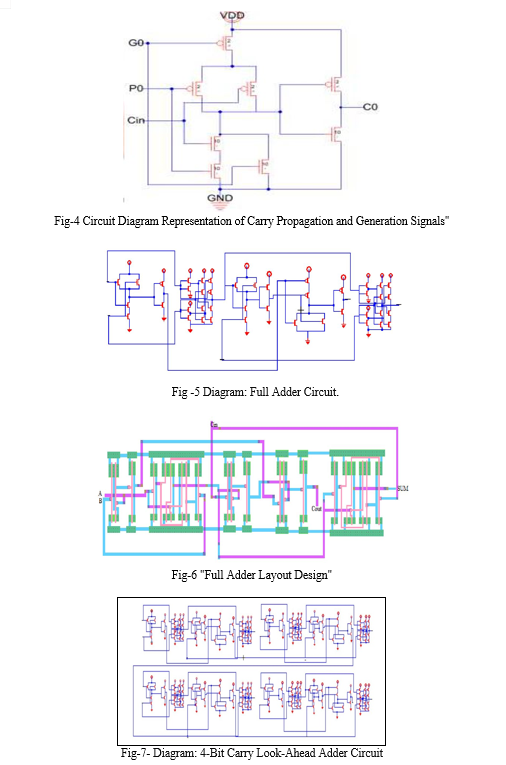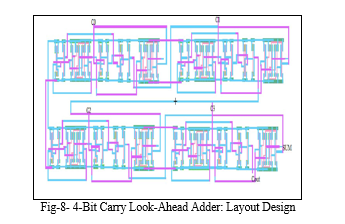Ijraset Journal For Research in Applied Science and Engineering Technology
- Home / Ijraset
- On This Page
- Abstract
- Introduction
- Conclusion
- References
- Copyright
16-Bit Carry Look-Ahead Adder: Design and Layout with Cadence Tools Top of Form
Authors: Chirag Gupta, Aakash Malik, Kamal Bhatia, Akash Yadav, Anshika Garg
DOI Link: https://doi.org/10.22214/ijraset.2024.58859
Certificate: View Certificate
Abstract
The development of highly organised architecture is the primary goal of the current communication world in order to achieve high speed computation with low power consumption. The Carry Look Ahead Adder is highly efficient due to its ability to reduce the propagation time of carry bits, resulting in time savings. The implementation of a 16-Bit Carry Look Ahead Adder using the Cadence tool is carried out in our project. Logical equations for carry generation (G) and carry propagation (P) are used to create the carry and sum for the 1-bit adder. Then, using the Virtuoso schematic editor, a single bit carry is developed. After that, a fresh cell view for the carry block is made and supplied as an input for adder implementations. Next, the bit rate is increased to 4 bits. Using this 4 bit adder, 8/16 bit adder is implemented using Cadence tool. It is necessary to have a basic understanding of IC design guidelines and fabrication procedures in order to produce the layout. Within the electronic VLSI design system, the layout will go through a Design Rule Check to find any breaches
Introduction
I. INTRODUCTION
In advanced digital systems, many adder circuits have delay due to Carry Generation for each bit. It significantly affects how well digital systems operate as a whole [1]. We have chosen Carry Look Ahead Adder from the other adder structures that are available for addition operations, including Carry Select Adders, Carry Increment Adders, Carry Skip Adders, and others. This choice was made due to its potential to decrease the number of gates that a carry signal needs to traverse in order to propagate during the generation and calculation of propagation values, thereby resulting in a reduction in delay. Carry Look Ahead Adders are a convenient technique to quickly add numbers. This approach avoids the need for a bottleneck to form as a result of the carry signal propagating step by step. The majority of embedded System processing modules as well as microprocessor systems have made extensive use of the Arithmetic Logic Unit [3]. All processors with adders generally need to operate at a high speed. Consequently, increasing the speed of the carry chain is necessary to increase the speed of the adders [3]. Due to our lesser power requirements, we choose to utilize the carry look ahead adder.. When adding becomes faster in an arithmetic operation, all other arithmetic operations also get faster. In the majority of situations, we favour carry look ahead adders since they minimise the carry propagation latency and provide excellent performance. The Carry Look Ahead Adder is a technique that can be employed to expedite the carry computations. Carry Look Ahead Adders are the quickest method for adding two binary values in order to minimise computation time.

To facilitate the more straightforward integration, verification, and implementation of complicated circuits. The Cadence Virtuoso Platform is an instrument for creating fully customized integrated circuits, encompassing schematic input, extraction, and back-marginal notation. Cadence's simulator- independent environment lowered the learning curve. Advanced full custom polygon editing (L) is now available. The most extensive selection of process design kits (PDKs) for process nodes worldwide, supplied by top foundries worldwide, counterbalances the virtuoso platform. Circuits from basic 7nm process nodes to 0.6µm can be stimulated by it.
Integrated circuits are built using a variety of technologies, such as NMOS, PMOS, bipolar, and CMOS. The preference for CMOS technology stems from its lower power consumption, as power is solely utilized during the switching of NMOS and PMOS transistors from on to off states.
II. PROPOSED METHOD
In digital electronics, addition is a fundamental process. However, the carry signal propagates slowly through several digital components. Utilizing the Carry Look Ahead Adder can significantly decrease the propagation time of the carry bit.
Following that, we have analyzed the fundamental structure of the Carry Look Ahead Adder (CLA). The CLA relies on two primary signals, namely the Propagate Signal (P) and the Generate Signal (G).


The CLA adder utilizing a 1-bit full adder is depicted in Figure 2 [5]. The full adder produces the carry propagate, carry generate, and the sum of the corresponding bits. These carry propagate and carry generate bits are then fed into the carry look ahead adder, and the final carry is generated by the CLA generator. Figure 3 illustrates the carry look ahead adder, which employs logic gates like the Exclusive OR gate, AND gate, and OR gate.
III. INTEGRATED CIRCUIT DEVELOPMENT
Transistors, wires, and bias are the three basic parts used to build integrated circuit layouts. Layout design is subject to design rules, which specify how different components should be arranged and interact with one another. In order to incorporate several functions onto a single chip, IC designers strive to reduce component sizes as much as feasible. Errors can occur throughout the fabrication process since wires and transistors are small components. Design guidelines are therefore created to reduce these mistakes. Creating design guidelines helps to raise to a suitable level the yield of precisely manufactured chips. Hence, it is crucial to take into account the design rule when designing the layout. The project's verification process will include DRC, LVS and ERC. These procedures play a significant role in IC layout and should not be underestimated.
A. Design Rule Check (DRC)
The chip's physical layout is examined to see if it conforms to the specified design rules using the Design Rule Check (DRC) verification technique. It confirms that all layers follow production guidelines, such as those regarding width and spacing. Following layout preparation, DRC is the first stage of verification. It assesses the design in the context of its intended application in addition to looking at design guidelines. Design dependability is improved with DRC by lowering the possibility of design flaws. As such, while potentially incomplete, it provides instantaneous analysis.
B. Layout Vs Schematic (LVS)
The process of Layout versus Schematic (LVS) is utilized to verify if an IC layout accurately matches the original schematic circuit of the design. All signals—inputs, outputs, and power signals—have their electrical connections examined during this procedure to make sure they match the corresponding devices accurately. As part of the LVS process, the dimensions of the devices are thoroughly examined. This includes verifying the width and length of the transistors, as well as assessing the sizes of the resistors and capacitors. Additionally, LVS identifies any additional components and indicators that may not have been depicted in the diagram. Initially, NCC uses a technique called local partitioning to find circuit incompatibilities. Next, NCC applies a second-generation layout validation tool called the Gemini algorithm.
C. Electric Rule Check (ERC)
When examining device connections or connectivity issues, ERC (Electrical Rule Check) is frequently used. It acts as an extra level of optional verification. ERC is used to identify any redundant, partially connected, or disconnected devices. It also checks for short circuits, floating nodes, and deactivated transistors.
The table above illustrates the basic principle of IC design, with all measurements given in lambda. It outlines the design guidelines for diffusion, poly, metal 1, metal 2, cut, and via. The alignment rule for cut or via surrounding and poly space to diffusion is 1λ, while for poly overlapping diffusion it is 2λ.
|
LAYER |
WIDTH |
SPACE |
|
POLY |
2 |
3 |
|
DIFF |
3 |
3 |
|
METAL 1 |
3 |
3 |
|
METAL 2 |
3 |
4 |
|
N WELL |
12 |
6 |
|
CUT |
2 |
2 |
|
VIA |
2 |
3 |
IV. LAYOUT DESIGNING
Physical Design of the CLA in the VLSI system has been done utilizing a variety of technologies. The author of this paper
- Has provided a technique for creating an IC layout with 90nm technology. Where in the fully bespoke and semi-custom methods were both applied. Comparing the variations in area efficiency and power dissipation between semi-custom and full-custom techniques was the key to evaluating CLA performance. The outcome demonstrates that, in contrast to the fully custom way, the semi-custom method results in a small area and slow power consumption.
- Using cadence GPDK and 90nm technology, the circuit was analyzed. The transient analysis is used to interpret the circuit's power consumption values. The results show that using the short pulse successfully turned on the logic block for the required short amount of time, which minimized wasteful use. Constant Delay (CD) logic was employed in this paper
- To lower the power delay product and dissipation. H-Spice was used for the simulation, while Cosmo Scope Z 2007.03 was used to check the latency. Better PDP is produced by the CD logic, which focuses mostly on critical path delay improvement.
- The efficiency of CLA was evaluated by comparing the propagation delay, power dissipation, and the resulting product. The Tanner EDA tool was used to simulate the circuit while taking into account various feature sizes (150, 200, and 250 nm). The 8-bit pseudo-NMOS CLA implementation required the most average power, according to the paper's data, whereas the 4-bit normal CMOS CLA implementation required the least average power. Using Xilinx as a synthesis tool, this paper
- This research, utilizing Xilinx as the synthesis software, concentrates on the utilization of Verilog code for the design and simulation of 4/8/16 bit CLA circuits. The findings indicate that the adder with carry look-ahead exhibits the most favorable area-delay product.
- Power dissipation and PDP results were compared to determine the performance. Tanner environment with 90nm and 180nm technology was used for simulation. Moreover, carry skip adder has the least PDP. The alternative log-n stage design that the author provides in this study achieves almost ideal performance in terms of maximum connector wire length, area-time efficiency, and regularity.
- The CLA's structure becomes noticeably regular when input and output are limited, making it easier to add two n-bit values in a time of zero.
V. METHODOLOGY
We will work using program called Electric Cad. And make use of its potent tools. And will employ wave viewer and schematic recording using LT Spice IV simulation software. The gates in CLA are AND, XOR, and OR. We can construct, carry, generate, and propagate signals using gates. The propagate and create signal schematic diagram is displayed in Fig. 4. It will be used during the entire CLA process. It can be 4, 8, 16, 32, or many other bits. Figure 5 displays the Circuit Diagram of a 1-bit partial full adder, while Figure 7 showcases the Circuit Diagram layout of a 4-bit CLA. We will Perform a DRC check at each level of layout design in order to find any errors.


Conclusion
After receiving the output from the layout design, we will examine the CLA\'s transient and frequency response using the results of the simulation. Additionally, a user-friendly tool for designing complex circuit architectures is provided via the open-source Electric VLSI platform. With the use of this program, we may also be able to handle more complicated circuits and use the IRSIM simulator to determine their transient response. Reduction in delay, power consumption, and memory usage has been achieved. Carry look ahead adders play a crucial role in reducing the carry propagation time of the adder in comparison to different logic designs. Now using the 4 bit CLA schematic we have to design 8/16 bit CLA and then design the layout of that 8/16 bit CLA.
References
[1] Design and Implementation of Low Power 8-bit Carry-look Ahead Adder Using Static CMOS Logic and Adiabatic Logic -Mr. Abdul Sajid, Mr. Ahmad Nafees, Mr. Saifur Rahman (Nov 2013) [2] Analysis Of Different Types Of Adders: A Review -Jasbir Kaur, Neeraj Singla PEC University of Technology, Chandigarh [3] Comparison Between Various Types of Adder Topologies By Jasbir Kaur, and Lalit Sood [4] Evaluation of High Speed and Low Memory Parallel Prefix Adders - A.Madhu Babu, K.Harikrishna . [5] Performance Analysis of Different Types of Adder for High Speed 32 Bit Multiply And Accumulate Unit -Akash Kumar, Deepika Sharma. [6] A 16-bit Carry-Lookahead Adder Using Reversible Energy Recovery Logic for Ultra-Low-Energy Systems-Joonho Lim, Dong-Gyu Kim, and Soo-Ik Chae. [7] A Reconfigurable Approximate Carry Look-Ahead Adder -Omid Akbari1, Mehdi Kamal1,2, Ali Afzali-Kusha1, Massoud Pedram (2016). [8] Design of 16 Bit Carry Look Ahead Adder Using Reversible Logic- Shailja Shukla, Tarun Verma and Rita Jain (17 April 2014). [9] Anku Bala “Layout and Design Analysis of Carry Look Ahead Adder Using 90nm Technology”, Int.Journal Of Electrical & Electronics Engg. Volume 2, spl..issue1, 2015 [10] Amuthavalli G. and Gunasundari R, “Analysis Of 16-Bit Carry Look Ahead Adder – A Subthreshold Leakage Power Perspective”, ARPN Journal of Engineering and Applied Sciences Volume-10, NO. 6, April 2015. [11] Jagannath Samanta, Mousam Halder, Bishnu Prasad De, “Performance Analysis of High Speed Low Power Carry LookAhead Adder Using Different Logic Styles”, International Journal of Soft Computing and Engineering (IJSCE), Volume-2, Issue-6, Jan- 2013. [12] R.Kathiresan, Dr. M.Thangavel, K.Rathinakumar, S.Maragadharaj, “Analysis Of Different Bit Carry Look Ahead Adder Using Verilog Code”, International Journal of Electronics and Communication Engineering & Technology(IJECET), Volume 4, Issue 4, July-August, 2013. [13] Jatinder Kumar, Parveen Kaur, “Comparative Performance Analysis of Different CMOS Adders Using 90nm and 180nm Technology”, International Journal of Advanced Research in Computer Engineering & Technology (IJARCET) Volume 2 Issue 8, August 2013. [14] Tin Fbok & Marry Jane Irwin “Regular. Area-Time Efficient Carry-Look Ahead Adders”, 1985 IEEE. [15] Mr. Abdul Sajid, “Design and Implementation of Low Power 8- bit Carry-look Ahead Adder Using Static CMOS Logic and Adiabatic Logic”, I.J. Information Technology and Computer Science, 2013. [9] Peter Cheung, “Layout Design”, Department of Electrical & Electronic Engineering Imperial College London [16] Rajender Kumar, Sandeep Dahiya SES, BPSMV, Khanpur Kalan, Gohana, Sonipat, Haryana, Performance Analysis of Di?erent Bit Carry Look Ahead Adder Using VHDL, Environment International Journal of Engineering Science and Innovative Technology (IJESIT) Volume 2, Issue 4, July 2013. [17] Jagannath Samanta, Mousam Halder and Bishnu Prasad De, Performance analysis of high speed low power carry-lookahead adder using di?erent logic styles, International Journal of Soft Computing and Engineering (IJSCE), vol. 2, issue 6, pp. 330336, Jan- 2013. [18] Implementation of high peeformance spanning tree adder using quaternary logic Tati Padma, 2 K.Krishna Reddy, 3 S.S.G.N.Srinivasa Rao. [19] V. Reethika Rao, Dr. K. Ragini, “Comparative Analysis Of 32 Bit Carry Look Ahead Adder using Constant Delay Logic”, International Journal of Science, Engineering and Technology Research (IJSETR),Volume 3, Issue 10, October 2014
Copyright
Copyright © 2024 Chirag Gupta, Aakash Malik, Kamal Bhatia, Akash Yadav, Anshika Garg. This is an open access article distributed under the Creative Commons Attribution License, which permits unrestricted use, distribution, and reproduction in any medium, provided the original work is properly cited.

Download Paper
Paper Id : IJRASET58859
Publish Date : 2024-03-08
ISSN : 2321-9653
Publisher Name : IJRASET
DOI Link : Click Here
 Submit Paper Online
Submit Paper Online

